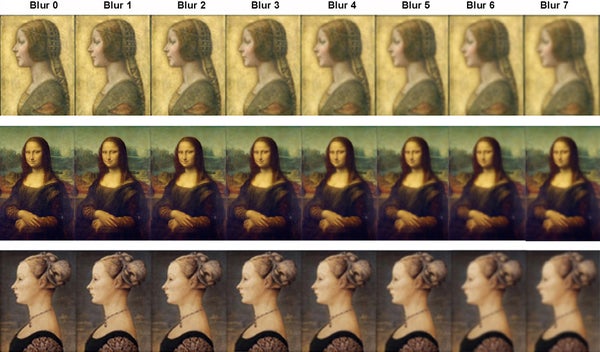This article was published in Scientific American’s former blog network and reflects the views of the author, not necessarily those of Scientific American
Ed. Note: Some of the information here about the Mona Lisa was previously described in: Martinez-Conde, S. and Macknik, S.L. (2010, May 1st). What's in a Face? Scientific American, 3-4. https://www.scientificamerican.com/article/whataposs-in-a-face/?page=4
Perhaps The Mona Lisa is the most famous painting in history because her enchanting smile is art’s most enigmatic mystery. By looking directly at Mona Lisa's lips, we notice that her smile is understated, almost nonexistent. But after looking into her eyes or the part in her hair (while paying attention to her mouth), her smile becomes much wider. Indeed, as we gaze around Mona Lisa's face, our eyes’ movements animate her smile—a dancing grin that is altered with our perceptions. These mechanisms distinguish stimuli in the middle versus the margins of our sight, which scientists refer to as the central versus peripheral retina.
In the visual field, the center and the periphery possess a different initial effect on perception. While the neurons at the center of our vision see a very small portion of the world—giving us high-resolution vision—neurons in the periphery perceive larger portions of the visual scene, and hence possess lesser resolution.
On supporting science journalism
If you're enjoying this article, consider supporting our award-winning journalism by subscribing. By purchasing a subscription you are helping to ensure the future of impactful stories about the discoveries and ideas shaping our world today.
THE DA VINCI CODE OF PERCEPTION
Mona Lisa's ambiguous smirk has thus been explained by a simple visual principle: when images are blurred in the periphery of our vision, her smile is also blurred: Professor Margaret Livingstone at Harvard Medical School first explained this conundrum through a simulation. She wanted to know how the visual system saw Mona Lisa's smile in the far periphery, the near periphery, and in the center of our gaze. The experiment was conducted in Adobe Photoshop. By merely obscuring and clarifying the painting to replicate the transformation in resolution from the center of our visual field to the far periphery, Livingstone got her answer: Mona Lisa’s smile deepens in the figure below as it becomes more blurred towards the right. It is also explained through the notion that different retinal neurons are adjusted to varying the content of spatial size information in the image, which scientists refer to as its spatial frequency distribution. By some estimations, Leonardo da Vinci painted the Mona Lisa as a fusion; a happy Mona Lisa overlaid on a sad one, with each possessing a different spatial-frequency.
A veritable cottage industry of scientific studies on Mona Lisa followed. Now a new study examines another enigmatic da Vinci smile, from a painting that—until recently—was lost.
LA BELLA PRINCIPESSA
Alessandro Soranzo and Michael Newberry from Sheffield Hallam University have examined a painting called La Bella Principessa that only recently was shown to be painted by da Vinci himself. The study, published in—Vision Research—determined that the smile’s enigmatic qualities followed from the same principles as the Mona Lisa Smile. They confirmed that it did, and that a similar painting (by a different artist) from the same period, did not. They argue that Mona Lisa’s own enigmatic smile—which was painted after La Bella Principessa’s—was therefore not a fluke, but an intentional feature of da Vinci’s mastery in expressing subtle emotions.

Top: Progressively blurred La Bella Principessa (da Vinci). Middle: The Mona Lisa (da Vinci). Bottom: Portrait of a Girl (Piero del Pollaiuolo, 1470). From: Soranzo A., Newberry M. (2015) “The uncatchable smile in Leonardo da Vinci’s La Bella Principessa portrait”. Vision Research. Volume 113, pp. 78-86.